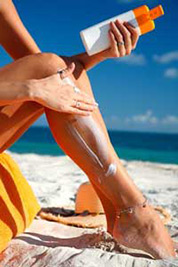Sunprotection
In the past, sun exposure was thought to be a health benefit of outdoor activity. sunlight can be used to treat some skin diseases, but we all need to avoid overexposure to the sun. Too much sun can cause wrinkles, freckles, skin texture changes, dilated blood vessels and skin cancers. It may also cause other problems.
How Can the Sun Damage You?
Part of the sun’s energy that reaches us on earth is composed of rays of invisible ultraviolet (UV) light. When ultraviolet light rays (UVA and UVB) enter the skin, they damage the skin cells, causing visible and invisible injuries.
Sunburn is a visible type of damage, which appears just a few hours after sun exposure. In many people, this type of damage also causes tanning. Freckles, which occur in people with fair skin, are usually due to sun exposure. Freckles are nearly always a sign that sun damage has occurred, and therefore show the need for sun protection.
Ultraviolet light rays also cause invisible damage to skin cells. Some of the injury is repaired, but some of the cell damage adds up year after year. After 20 to 30 years or more, the built-up damage appears as wrinkles, age spots, and even skin cancer. Although window glass blocks UVB light, UVA rays are able to penetrate through glass.
The sun’s harmful effects are also increased by wind and reflections from water, sand and snow. Even on cloudy days UV radiation reaches the earth.

Types of Damage
Severe sunburns may be related to the development many years later of the most dangerous kind of skin cancer called melanoma. Melanomas can develop in all age groups, including teenagers and young adults. Melanomas can spread to other parts of the body and are potentially fatal.
Built-up invisible sun damage can lead to skin cancer. Basal cell skin cancers usually develop in middle and later life, but can appear as early as the teenage years. These cancers rarely spread to other parts of the body. However, their continuous destruction of skin and underlying structures makes their removal necessary. Squamous cell skin cancers can spread to other parts of the body if they are not treated early.These cancers are seen more in fair or lighter skinned individuals.
Tips for Sun Protection
We get about 80 percent of our total lifetime sun exposure in the first 18 years of life. Therefore, sun prevention in childhood is very important to prevent skin cancer later in life. Sun protection should begin in infancy and continue throughout life.
Stay Away
- Stay away from the midday sun and its intense rays. Schedule play times and outdoor activities before 10:00 A.M. and after 4:00 P.M. (daylight savings time 9:00 A.M. to 3:00 P.M.). The sun’s energy is greatest when it travels through less atmosphere at midday. Sun exposure is more intense closer to the equator, in the mountains, and in the summer. The sun’s damaging effects are increased by reflection from water, white sand, and snow.
- Avoid long periods of direct sun exposure. Sit or play in the shade, especially when your shadow is shorter than you are tall.
- Avoid sunburn. Be aware of the length of time you are in the sun. It may take only 15 minutes of midday summer sun to burn a fair-skinned person.

Use a Sunscreen Lotion
Block sun damage by applying a broad-spectrum UVA & UVB sunscreen lotion, gel or sunstick with a SPF 15 or higher and reapply every two hours even on cloudy days. If swimming or participating in intense physical activity, sunscreen may need to be applied more often.
Choose a sunscreen with a SPF 15 or higher. The protective ability of sunscreen is rated by Sun Protection Factor (SPF) – the higher the SPF, the stronger the protection. Apply sunscreen and Spread it evenly over all uncovered skin, including ears and lips, but avoiding eyelids. Apply sunscreen about 30 –45 minutes before sun exposure. Even water-resistant sunscreens should be reapplied often, about every two hours or after swimming or strenuous activities.
Invisible sunscreens work by trapping the ultraviolet energy and preventing that energy from damaging the skin.
Visible opaque white or colored sunblock creams prevent all light from entering the skin. They often contain zinc oxide or titanium dioxide (“chemical-free” sunscreens). They are useful for high-risk areas such as the nose, lips, and shoulders.
Dress Up For it
Most clothing absorbs or reflects UV rays, but white fabric like loose-knit cotton and wet clothes that cling to your skin do not offer much protection. The tighter the weave, the more sun protection it will offer cover up with a hat and light-colored clothing when outdoors. Don’t play or work outdoors without a shirt. Put on a shirt and hat after swimming or wear a T-shirt while swimming. In addition to filtering out the sun, tightly woven clothing reflects heat and helps keep you feeling cool. Sunglasses that block ultraviolet rays protect the eyes and eyelids.
Everyone should be able to enjoy sunny days and chill out. By using a little common sense you can safely work and play outdoors without worrying too much about the sun damage
DISLAIMER:
THE INFORMATION IN THIS ARTICLE REFLECTS THE VIEWS OF THE AUTHOR ONLY. A QUALIFIED HEALTH CARE PROFESSIONAL SHOULD BE CONSULTED BEFORE USING ANY THERAPEUTIC PRODUCT DISCUSSED. ALL READERS SHOULD VERIFY ALL INFORMATION AND DATA BEFORE TREATING PATIENTS OR UTILIZING ANY THERAPIES NOTED IN THIS PROGRAMME.

